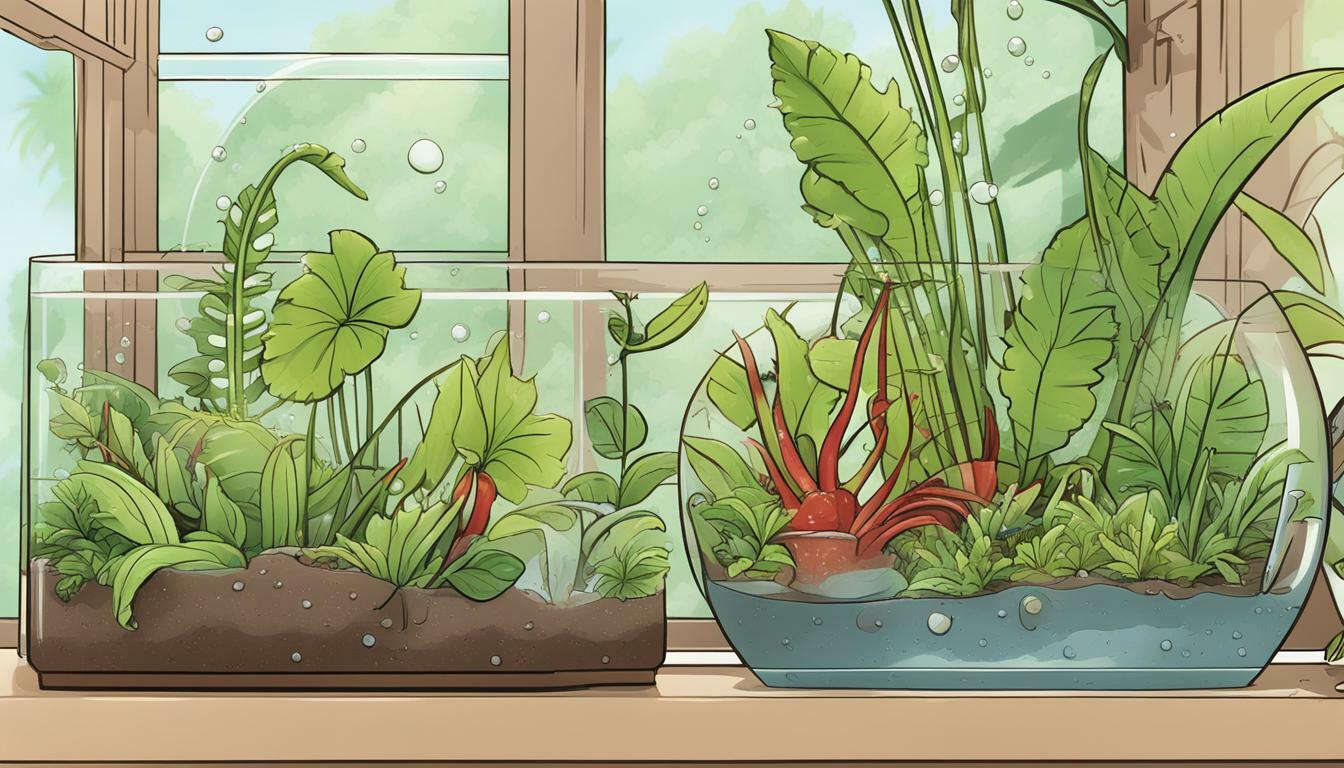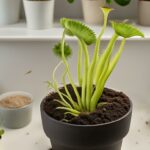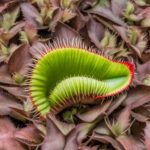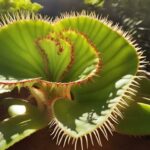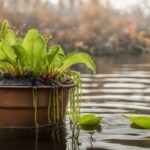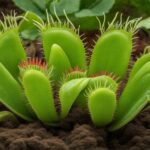If you’re interested in growing Venus flytraps, you may be wondering about the types of environments they can thrive in. One question that often arises is whether or not Venus flytraps can tolerate high humidity. In this section, we’ll explore the tolerance levels of these unique plants to high humidity and discuss how you can care for them in humid environments.
Key Takeaways:
- Venus flytraps can tolerate high humidity to a certain extent.
- The ideal humidity range for Venus flytraps is between 50-60%.
- Proper watering and air circulation are critical in maintaining Venus flytrap health in high humidity environments.
Understanding Venus Flytrap’s Humidity Requirements
Venus flytraps, like most carnivorous plants, have unique humidity requirements that differ from other houseplants. In their native habitat, they grow in nutrient-poor soils that are perpetually moist, and the air around them is humid as well. Therefore, they require a relatively high level of humidity to thrive.
The ideal humidity range for Venus flytraps is between 50% and 60%. However, they can tolerate humidity levels as low as 40% and as high as 70%. The plant adjusts to different humidity levels by adjusting the size of the pores on their leaves. When the humidity is low, the pores open wider to absorb more moisture, and when the humidity is high, the pores close to prevent excess water loss.
It’s important to note that the humidity level required for Venus flytraps may vary depending on their growing conditions. Plants grown in a terrarium or greenhouse with limited air circulation will require higher humidity than those grown outdoors or in a well-ventilated room. Therefore, it’s essential to monitor the humidity levels and adjust accordingly.
Growing Venus Flytraps in High Humidity Environments
If you live in an area with high humidity levels, you may wonder if your Venus flytrap can thrive in such conditions. The good news is that these carnivorous plants can tolerate humid environments, but they require proper care and attention to flourish.
To ensure the best growth of your Venus flytrap, you need to consider factors like watering, air circulation, and temperature. Here are some practical tips to help you care for your Venus flytraps in high humidity:
| Aspect | Care tips |
|---|---|
| Watering | Do not overwater your Venus flytrap in high humidity, as too much moisture can cause root rot. Instead, ensure that the soil is consistently moist but not soggy. Use rainwater, distilled water, or reverse osmosis water to prevent buildup of minerals and salts in the soil. |
| Air circulation | Ensure proper ventilation to allow adequate air circulation. Avoid placing your Venus flytrap in a closed or sealed container, as this can lead to excessive humidity and stagnant air that can cause fungal diseases. |
| Temperature | Maintain the ideal temperature range of 70-85°F (21-29°C) for your Venus flytrap to grow. High humidity can make the temperature feel hotter, so ensure that your plant is not exposed to direct sunlight or heat sources like radiators, which can cause stress or damage. |
| Potting medium | Use a well-draining soil mix that holds moisture but allows excess water to drain away. A mixture of sphagnum peat moss, perlite, and sand or vermiculite can provide good aeration and moisture retention for your Venus flytrap. |
While Venus flytraps can tolerate high humidity, they may face some challenges in such environments. For example, high humidity can attract pests like fungal gnats or spider mites, which can harm your plant. If you notice any signs of infestation or disease, take prompt action to address the problem.
In summary, growing Venus flytraps in high humidity requires attention to detail and adherence to specific care requirements. By providing proper care, you can enjoy the beauty and wonder of these fascinating plants in your humid environment.
How Well Do Venus Flytraps Handle Humidity?
Venus flytraps are naturally adapted to thrive in humid environments. Their native habitat, the Southeastern United States, is known for its high humidity levels. As a result, Venus flytraps can handle a wide range of humidity levels, and they are generally tolerant of high humidity.
However, excessive humidity can have negative effects on Venus flytraps. In extremely humid conditions, the plants may have difficulty absorbing nutrients and may be more vulnerable to root rot and other diseases. In addition, high humidity can often mean poor air circulation, which can lead to mold growth on the plants.
To ensure that your Venus flytraps thrive in high humidity environments, it’s important to provide proper care. One key aspect of caring for Venus flytraps in humid conditions is to water them properly. In humid environments, the soil of Venus flytraps may stay moist for longer periods of time, so be sure to monitor the moisture levels and adjust your watering schedule accordingly. You may also want to consider using a well-draining soil mix to help prevent root rot.
Another important factor in caring for Venus flytraps in high humidity is to provide adequate air circulation. This can be achieved by placing a fan near the plants or by keeping them in a well-ventilated area. If you notice mold growth on your plants, increase the air circulation to help prevent further growth.
In Conclusion
Overall, Venus flytraps are well-adapted to high humidity environments and can thrive in such conditions with proper care. By providing adequate moisture levels, well-draining soil, and proper air circulation, you can enjoy the unique beauty of these fascinating plants in even the most humid environments.
Conclusion
Overall, Venus flytraps are remarkably adaptable plants that can tolerate a wide range of conditions, including high humidity. Understanding their specific needs and providing adequate care can help ensure their health and longevity in humid environments.
When it comes to growing Venus flytraps in high humidity, it’s essential to monitor their watering and ensure adequate air circulation to prevent mold and other moisture-related issues. Additionally, providing them with the right soil mix and regular fertilization will support their growth and help them thrive.
While excessive humidity can have negative effects on Venus flytraps, they are generally well-equipped to handle humid conditions, thanks to their natural adaptation. By maintaining appropriate humidity levels and addressing any potential challenges promptly, you can enjoy the beauty and wonder of these fascinating plants in any environment.
Is It Beneficial for Venus Flytraps to Have Dead Bugs in Their Diet?
Venus flytraps and dead bugs interactions are indeed beneficial for these carnivorous plants. As they rely on capturing live prey, dead bugs serve as a convenient food source. Not only do the dead bugs provide extra nutrients, but their presence also triggers the closure of the trap, stimulating digestive processes within the plant. This interaction ensures the Venus flytrap’s survival and enables it to thrive in nutrient-poor environments.
FAQ
Q: Can Venus Flytraps tolerate high humidity?
A: Yes, Venus Flytraps can tolerate high humidity. They are naturally adapted to humid environments and can thrive in such conditions.
Q: What are the humidity requirements for Venus Flytraps?
A: Venus Flytraps prefer a humidity level of around 50-70%. This range provides the ideal moisture levels for their growth and development.
Q: How do I grow Venus Flytraps in high humidity environments?
A: To grow Venus Flytraps in high humidity environments, it is important to ensure proper watering to maintain moisture levels. Additionally, providing good air circulation and avoiding excessive moisture buildup can help prevent issues such as fungal diseases.
Q: How well do Venus Flytraps handle humidity?
A: Venus Flytraps handle humidity quite well, as they have natural adaptations that allow them to thrive in humid conditions. However, excessive humidity can potentially lead to fungal infections, so it is important to monitor and maintain balanced moisture levels.

